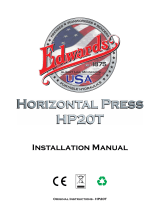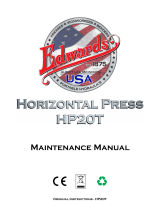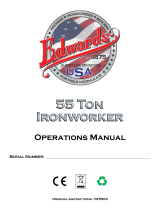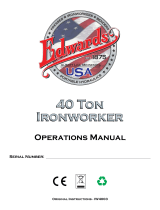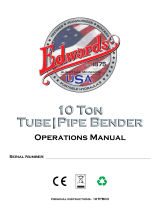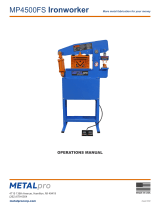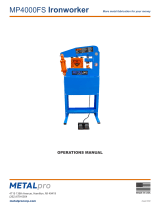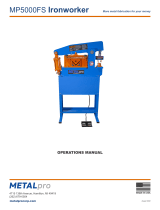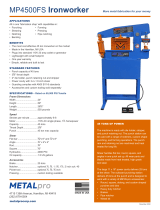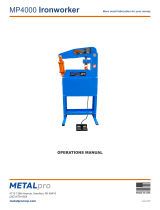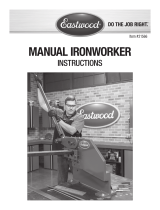Page is loading ...

Radius Roller
RRM2
Operations Manual
Original Instructions - RRM2
Serial Number:

1 General
Declaration of E.C. Compliance
Company Prole
Warranty
Machine Identication
Operator and Supervisor Information
Signal Word Denition
Signal Word Panel
Operational Precautions
Machine Operations
6 Hydraulic Power Sources
Powering with an Edwards Ironworker
Powering with an Edwards Porta-Power
8 Operations Diagram
9 Component/Base Operations
Tilting Head-Frame Operation
Base Operation
10 Die Set Operations
Die Set Installation
11 Roll Forming
12 Rolling Common Sections
Roll Forming Flat Sections
Roll Forming Angle Sections
Roll Forming Round Sections
14 Troubleshooting
Operations manual Table of Contents Declarations of Conformity
EU DECLARATION OF CONFORMITY WITH COUNCIL DIRECTIVE 2006/42/EC
Date of Issue: 01/11/2013
Directive:
Machinery Safety Directive 2006/42/EC
Electromagnetic Compatibility Directive 2004/108/EEC
Low Voltage Directive 2006/95/ES
Conforming Machinery: Model: Radius Roller RRM2
Type: Hydraulic Accessory
Serial Number: Refer to Title Page
Manufacturer: Edwards Manufacturing Company
1107 Sykes Street
Albert Lea, MN 56007, USA
Person Authorized to compile the
Technical File Established in the EU
Julian Smith and Melanie Smith – Directors
Alpha Punch & Machinery Ltd
Unit 7 Binder Industrial Park
Eland Road
Denaby, Doncaster DN12 4HA
UK
Tel: 011-441709866083
Fax: 011-441709866356
Harmonised Standards
Referenced or Applied:
EN 13857:2008, EN ISO 13850:2008, EN 60204-1:2006+A1:2009/AC 2010, EN 12100:2010, EN 349:1993+A1:2008, EN 953:1997
+A1:2009, EN 1037:1995+A1:2008, EN 614-1:2006+A1:2009, EN ISO 4413:2010, BS EN 13849-1:2006
Specications with which Conformity is
Declared: Essential Health and Safety Requirements of Annex 1 of the Machinery Directive
We hereby certify that the machinery described above conforms with the essential health and safety requirements of Council Directive 2006/42/EC on the approximation of the laws of the
Member States relating to the safety of machinery.
Signed:
Signatory: Printed Name : Douglas L. Friend
Title: Chief Operating Ofcer
Technical File Reference Number SF11987A1.EMC
Notes Concerning Harmonized Standards Referenced or applied:
EN ISO 13857:2008 Safety of machinery. Safety distances to prevent hazard zones being reached by upper and lower limbs.
EN ISO 13850:2007 Safety of machinery — Emergency stop — Principles for design
EN 60204-1:2006+A1:2009/AC 2010 Safety of machinery. Electrical equipment of machines.
General requirements.
EN 349:1993+A1:2008 Safety of machinery. Minimum gaps to avoid crushing of parts of the human body.
EN 953:1997 +A1:2009 Safety of machinery. Guards. General requirements for the design and construction of xed and movable guards.
EN 1037:1995+A1:2008 Safety of machinery. Prevention of unexpected start-up
EN 12100:2010 Safety of Machinery – General Principles for design –
Risk Assessment and risk reduction.
EN 614-1:2006+A1:2009 Safety of machinery — Ergonomic design principles —.
Part 1: Terminology and general principles.
EN ISO 4413:2010 Hydraulic uid power - General rules and safety requirements for systems and their components
BS EN 13849-1:2006 Safety of machinery. Safety related parts of control systems. General principles for design
1

32
Company Profile
Edwards Manufacturing
Company manufactures
a full line of high quality,
low maintenance hydraulic
ironworking machines, associated
tooling and accessories that are used in the
steel fabrication industry. With proper operation, care,
and maintenance, your Edwards Ironworker or Hydraulic
Accessory Tool will provide years of safe, trouble-free
service. Please take time to study this Operator’s Manual carefully
to fully understand Ironworker and Hydraulic Accessory Tool safety
procedures, set-up, operation, care, maintenance, troubleshooting
and warranty coverage prior to putting the machine into production.
Any questions not answered within this manual can be directed
to your local Edwards Ironworker dealer or factory representative.
Contact the factory:
Edwards Manufacturing
Company
1107 Sykes Street
Albert Lea, MN 56007
507 373 8206 PHONE
507 373 9433 FAX
www.edwardsironworkers.com
General Questions:
sales@edwardsmfg.us
Service Questions:
service@edwardsmfg.us
Contact your dealer:
Warranty
Edwards Manufacturing Company will, within one (1) year
of date of original purchase (proof of purchase required),
replace F.O.B. the factory, any goods, excluding punches,
dies and shear blades, which are defective in materials or
workmanship provided that the buyer return the defective
goods, freight pre-paid, to the seller, which shall be the
buyer’s sole and exclusive remedy for the defective goods.
Hydraulic components are subject to their manufacturer’s
warranty.
Edwards Manufacturing Company will, within thirty (30) days
of date of original purchase (proof of purchase required),
replace F.O.B. the factory, any punches, dies and/or shear
blades, which are defective in materials or workmanship.
This warranty does not apply to machines and/or components
which have been altered, changed or modied in any way,
or subjected to abusive and abnormal use, inadequate
maintenance and lubrication, or subjected to use beyond
seller recommended capacities and specications. Edwards
Manufacturing Company shall not be liable for labor costs
expended on such goods or consequential damages.
Edwards Manufacturing Company shall not be liable to
the purchaser or any other person for loss, down-time, or
damage directly or indirectly arising from the use of the
goods or from any other cause. No ofcer, employee, or
agent of Edwards Manufacturing Company is authorized to
make any oral representations or warranty of tness or to
waive any of the foregoing terms and none shall be binding
on Edwards Manufacturing Company.
Machine Identification
Your Edwards Radius Roller has been serialized for quality control,
product traceability and warranty enforcement. Please refer to the
aluminum identication tag with engraved serial number and power
specications when ordering parts or ling a warranty claim.
DECLARATION OF NOISE EMISSION Sound Pressure and Sound Levels per EN ISO 1102
Date of Issue: 01/11/2013
Machinery:
Model: Radius Roller RRM2
Type: Hydraulic Accessory
Serial Number: Refer to Title Page
Operating Idle
LpAm (Operator Position) 84 dB (A) 43 dB (A)
LpAm (Bystander Position) 81 dB (A) 41 dB (A)
Peak C-weighted instantaneous SPL in the Operator’s position LpCpeak 95 dB (C) ---
Sound power emitted where the equivalent continuous A-weighted SPL exceeds 80 dB (A). 8.4 Bel ---
The average difference between the extraneous noise level and the sound intensity level at each measuring point is: LpAm Δ = 41 dB (A)
Ambient Correction Factor K3A calculated according to EN ISO 11204 Appendix A. 4 dB( A)
Measurements were made at a height of 1.5 m and 1 m from the Operator Position and all four sides of the equipment.
The gures quoted are emission levels and are not necessarily safe working levels. While there is a correlation between the emission and exposure levels this cannot be used reliably to
determine whether or not further precautions are required.
Factors that inuence the actual level of exposure of the workforce include characteristics of the work room, the other sources of noise, etc. such as the number of machines and other
adjacent processes. Also, the permissible level of exposure can vary from country to country.
This information, however, will enable the user of the machine to make a better evaluation of the hazard and risk.
Edwards Manufacturing Company 1107 Sykes Street Albert Lea, MN 56007 USA
Declaration of Conformity with ANSI / ISO / NFPA / OSHA Standards relating to the Manufacture of Ironworking Machinery
Date of Issue: 12/05/2013
Applicable Standards: ANSI / ISO / NFPA / OSHA
Conforming Machinery: Model: Radius Roller
Type: Hydraulic Accessory
Serial Number: Refer to Title Page
Manufacturer: Edwards Manufacturing Company
1107 Sykes Street
Albert Lea, MN 56007, USA
Harmonised Standards
Referenced or Applied:
ANSI B11.05, ANSI B11.0, ANSI B11.19, ANSI / ASSE Z244.1, ANSI Z535.2, ANSI Z535.3, ANSI Z535.4, ANSI Z535.5, ANSI / ISO 12100, ISO
13849-1, NFPA 79, OSHA1910.147, OSHA1910.212, OSHA1910.219
We hereby certify that the machinery described above conforms with the essential health and safety requirements of Council Directive 2006/42/EC on the approximation of the laws of the
Member States relating to the safety of machinery.
Signed:
Signatory: Printed Name : Douglas L. Friend
Title: Chief Operating Ofcer
Technical File Reference Number SF11987A1.EMC
Notes Concerning Harmonized Standards Referenced or applied:
ANSI B11.05 1988 (R2008) Ironworkers - Safety Requirements for Construction, Care and Use
ANSI B11.0 2010 Safety of Machinery - General requirements and Risk Assessment
ANSI B11.19 Performance Criteria for Safeguarding
ANSI / ASSE Z244.1 2003 (R2008) Control of Hazardous Energy - Lockout / Tagout and Alternate Methods
ANSI Z535.2 2011 Environmental and Facility Safety Signs
ANSI Z535.3 2011 Criteria for Safety Symbols
ANSI Z535.4 2011 Product Safety Signs and Labels
ANSI Z535.6 2011 Product Safety Information in Product Manuals, Instructions, and Other Collateral Materials
ANSI / ISO 12100 Safety of Machinery - General Principles for design - Risk Assessment and risk reduction.
ISO 13849-1 Safety of machinery. Safety related parts of control systems. General principles for design.
NFPA 79 2012 Electrical Standards for Industrial Machinery
OSHA1910.147 1989 The Control of Hazardous Energy (Lockout / Tagout)
OSHA1910.212 1971 General Requirements for all Machines
OSHA1910.219 1971 Mechanical Power Transmission Apparatus

4 5
Operator and Supervisor Information
This is one of four manuals supplied with your machine.
• Installation Manual
• Safety Instructions Manual
• Operations Manual
• Maintenance Manual
READ ALL MANUALS BEFORE OPERATING MACHINERY. Operating
machinery before reading and understanding the contents of all four
manuals greatly increases the risk of injury.
Each of the four machine manuals describe ‘best practices’ in handling,
installing, operating and maintaining your machine. The contents of
each manual is subject to change without notice due to improvements
in the machinery or changes in National or International standards.
All rights reserved. Reproduction of this manual in any form, in
whole or in part, is not permitted without the written consent of
Edwards Manufacturing Company.
Keep all manuals close to the machine to allow for easy reference when
necessary.
Provide operators with sufcient training and education in the basic
functions of the machine prior to machine operation.
Do not allow for operation of the machine by unqualied personnel. Ed-
wards Manufacturing Company is not liable for accidents arising from
unskilled, untrained operation.
Do not modify or change the machine without written authorization from
Edwards Manufacturing Company. Unauthorized modication to a ma-
chine may result in serious operator injury, machine damage and will
void your machine warranty.
Never leave a powered machine unattended. Turn machinery OFF be-
fore walking away.
This machine is manufactured for use by able bodied and able minded
operators only. Never operate machinery when tired or under the inu-
ence of drugs or alcohol.
Do not resell, relocate or export to a destination other than to the original
point of sale. Edwards has designed this machine to meet the stan-
dards of the original receiving country and is not liable for meeting any
governing body or performance standards beyond those of the original
receiving country.
Signal Word Definition
Indicates a hazardous situation that, if not avoided,
will result in death or serious injury.
Indicates a hazardous situation that, if not avoided,
could result in death or serious injury.
Indicates a hazardous situation that, if not avoided,
could result in mild or moderate injury.
Indicates information considered important, but not
hazard related.
Signal Word Panel on Machine
Critical machine safety information is identied on signal word labels. La-
bels are attached adjacent to the potentially hazardous locations of the
machine. Reference the Safety Instruction Manual for additional informa-
tion regarding the potentially hazardous condition identied on the label.
Review ALL labels on the machinery, reference the operational pre-
cautions and safe operations sections within this manual before any
operation activity is initiated.
Failure to read and understand the signal word labels afxed to the
machinery may result in operator death or injury.
Machine Operations
Edwards Radius Roller is a quick-connect, hydraulic accessory tool
capable of rolling at, angle, pipe and tube sections to variable
radiuses. This manual outlines the basic functions associated with
typical rolling operations and is neither intended to create a com-
prehensive list of, nor describe every operation possible with a roller
tool. Roller operations are dangerous and require extreme care
and caution in the preparation of the material being worked, the
roller set-up and the rolling operation. Please refer to the follow-
ing setup, safe operation and roller operation sections of this Manual
for an understanding of the potential hazards present in any rolling
operation.
Edwards Radius Roller features robust design and construction and is
designed for years of service when powered by an Edwards Ironworker
or Porta Power portable hydraulic unit. Please refer to all Edwards
power source manuals as well as the Safety, Installation, Operation
and Maintenance Manuals of the Radius Roller prior to operation of
the machinery.
The Radius Roller is constructed of four basic assemblies. The roll-
ing base holds the tilting head frame which houses the pyramid roller
assembly and the control components The un-powered top pressure
roller descends with a hand crank to apply pressure to the material
being worked. The bottom two, knurled, drive rollers are stationary and
move the material clockwise and counterclockwise.
The following pages detail the proper operations procedures for
setting up and safely operating the Edwards Radius Roller.
Operational Precautions
Reasonable, common sense safety precautions should be observed when
operating the Ironworker or Hydraulic Accessory Tool. The following pre-
cautions are described in order of their hazard.
Electrical Hazard
Dangerous high voltages are present inside the electrical enclosure
of this product. Only qualied, authorized, maintenance or service
personnel should gain access to the electrical panel.
Lockout Power
Danger, circuits are live. Lockout / tagout upstream power source
before any maintenance activity is performed.
Shear / Crush Hazard
Moving parts can cut and crush. Keep hands clear when servicing
and maintaining the Ironworker or Hydraulic Accessory Tool.
Hydraulic Fluid Hazard
Hydraulic hoses are under pressure. Pressurized uid can pierce
skin and cause severe injury. To avoid physical hazard, always wear
personal protective equipment when servicing / maintaining the
Ironworker or Hydraulic Accessory Tool.
Do Not Operate With Guard Removed
Physical barriers and guards have been designed and installed to
protect operator and maintenance personnel from moving parts that
can pinch, cut and crush. If it is necessary to remove guarding when
servicing your Hydraulic Accessory Tool, immediately replace guards
after service and prior to power being restored to the machinery.
Refer to Manuals
For safe installation, operation and maintenance of the machine,
read:
Installation Manual
Safety Instructions Manual
Operations Manual
Maintenance Manual
Wear Personal Protective Equipment
To avoid physical hazard wear protective eyewear, clothing, gloves,
footwear, head-gear and hearing protection.

6 7
Ironworker Hydraulic Accessory Package Hydraulic Accessory Tool Controls Edwards Porta-Power
Hydraulic Power Sources
Your Edwards Radius Roller is factory assembled and tested for optimum
performance when powered by Edwards Manufacturing Company rated
hydraulic power supplies.
The Radius Roller is powered by either an Edwards Ironworker with the
factory installed Hydraulic Accessory Control Package or an Edwards
Porta-Power, 5hp, 3000psi, portable power unit.
ALTERNATE POWER SOURCES ARE NOT RECOMMENDED
AND MAY COMPROMISE MACHINE OPERATION, MACHINE
HYDRAULIC WARRANTY AND OPERATOR SAFETY.
Follow electrical connection installation instructions for power supply as
set forth within the Installation Manual of the Edwards Ironworker or
Porta-Power.
Powering with an Edwards Ironworker
Power selection controls are located adjacent to the starter on the feed
side of the machine. Hydraulic quick connections and accessory controls
are located on the drop-off side or end cap of the machine.
With the Ironworker power off, install Radius Roller hoses, power and
control:
• Install the Radius Roller male and female accessory hydraulic
hoses to the ironworker male and female quick-connect hydraulic
ttings. Both ttings have a detent ball setting that must be aligned
to couple and uncouple hoses.
• Remove the safety cap at the push button port. Attach the Radius
Roller hand control male mil. spec. control cable to the female mil.
spec. accessory control port at your Ironworkers Hydraulic Acces-
sory package.
With all Ironworker and Radius Roller stations clear of hands, tools,
tooling, material or debris, power up the Ironworker by depressing
the green button on the starter box.
With the power on, your Ironworker machine will return to a neutral
position.
Turn the 3-position switch on the front of the machine case to the Ac-
cessory position. This operation disables the Ironworker and switches
control to the accessory hand control.
With the Radius Roller work station clear of hands, tools, tooling, mate-
rial or debris, test the Radius Roller operation by depressing the OUT
control button. Once depressed, the lower drive rolls of the Radius Roller
will rotate counter clockwise. Releasing pressure on the OUT control
button will stop roller rotation. Test the Radius Roller operation by de-
pressing the IN control button. Once depressed, the lower drive rolls of
the Radius Roller will rotate clockwise. Releasing pressure on the IN
control button will stop roller rotation.
Depress the red e-stop button to kill power at the Ironworker. To reset
power, twist the e-stop button and push start button at the Ironworker.
When disconnecting your Radius Roller simply reverse procedure.
Replace the safety cap at the push button port to restore power to
your Ironworker.
Powering with an Edwards Porta-Power
Your Edwards Porta-Power 5hp / 3000psi / Portable Power Unit will
power all your Edwards Hydraulic Accessories.
Follow electrical connection installation instructions as set forth within
these sections of the Installation Manual:
With the Edwards Porta-Power off, install accessory hoses, power and
control:
• Install the male and female Radius Roller hydraulic hoses to the
Porta-Power male and female quick connect hydraulic ttings ad-
jacent to the starterbox. Both ttings have a detent ball setting that
must be aligned to couple and uncouple hoses.
• Remove the safety cap at the push button port. Attach the Radius
Roller hand control, male mil. spec. control cable to the female mil.
spec. accessory push button port on the Porta-Power case.
With all Ironworker and Radius Roller stations clear of hands,
tools, tooling, material or debris, power up the Porta-Power by
depressing the green button on the starter box.
With the power on, your Radius Roller is in a neutral position.
With the Radius Roller work station clear of hands, tools, tooling,
material or debris, test the Radius Roller operation by depressing
the OUT control button. Once depressed, the lower drive rolls of the
Radius Roller will rotate counter clockwise. Releasing pressure on
the OUT control button will stop roller rotation. Test the Radius Roll-
er operation by depressing the IN control button. Once depressed,
the lower drive rolls of the Radius Roller will rotate clockwise. Re-
leasing pressure on the IN control button will stop roller rotation.
If the machine fails to cycle, power down the Porta-Power by depressing
the red button on the starterbox, consult the trouble shooting section of
the Operations Manual.
Depress the red e-stop button on the hand control to kill power at the
Porta Power. To reset power, twist the e-stop button and push start but-
ton at Porta Power.
When disconnecting your Radius Roller, simply reverse procedure.
Replace the safety cap at the push button port to restore power to
your Porta Power.

89
Radius Roller
Operations Diagram
Tilting Head Frame
Die Storage
Kickstand
Drive Rollers
Drive Shafts
Brush Guard
Wrench
Idler Shaft with grease zerk
Scale with Pointer
Pressure Roller Adjustment
Roll Speed Adjustment
Friction Plate Bolts
Hand Screw
Friction Plate
Component / Base Operations
Rolling Base
Hydraulic Hoses
Pressure Roller
Adjustable Thrust Rollers
Base Operation
The heavy duty, ½” formed steel plate design is balanced like a tripod
and rolls on 3 wheels. The “kickstand” at the rear of the Radius Roller
base allows you to push the kickstand down with your foot to deploy the
swiveling caster and easily roll the bender to your work station. When
located in the ideal location, ip the kickstand up to disengage the swiv-
eling caster and stabilize the Radius Roller on the oor.
Left: Kickstand up (disengaged) Right: Kickstand down (engaged)Horizontal Operating Position
Vertical Operating Position
Tilting Head-Frame Operation
The head-frame of your Edwards RRM2 Radius Roller is mounted with
a yoke and pin to a sleeve and stop mechanism in the roller stand. This
mounting conguration allows for the Roller enclosure to be operated
in either a horizontal or vertical orientation. Positive stops at 0 and 90
degrees provide for a exible and stable operation of the roller when
working with light or heavy weight shapes or long setups.
Rotate the tilting head frame with caution. To rotate the head frame,
release the hand screw on the sides of the rotational sleeves. Release
the four friction plate bolts (do NOT remove).
Rotate the tilting head frame by lifting from the base of the roller. Once
the roller is in its horizontal position, secure the hand screws on both
yokes into their respective detent locations. For extra support of the
enclosure, tighten the four 1/2” bolts on the friction plates. To return
to vertical, repeat this sequence in reverse while supporting the head
frame to its’ vertical resting place.

10 11
Your Edwards Radius Roller will roll-form at, angle, pipe and tube
sections to variable radiuses when equipped with the proper,
matched die sets and careful operation.
The Edwards RRM2 Radius Roller is shipped with one un-keyed,
smooth, universal pressure die and spacer kit as well as two keyed,
knurled, universal drive die and spacer kit. Die sets are designed to
center the forming work within the pyramid roller assembly.
Die sets are wearing parts. Periodic cleaning and/or replace-
ment of wearing surfaces is required to maintain the highest
quality nished parts.
DIE SET INSTALLATION
Drive Dies
With the head frame in its vertical position, carefully load the two,
keyed, knurled, universal drive die and spacer kits (3 pieces) onto the
lower, paired, keyed drive shafts. Dies must never touch the face of
the enclosure and must have the same orientation to the face of the
enclosure. Arrange the 3 pieces to accommodate the work at hand.
Always orient the mass of your section being formed towards the
face of the enclosure. This orientation greatly reduces the cantilever
forces being applied to the drive shafts and internal bearings.
Install shafting washers and nuts to hand tight.
Pressure Dies
With the pressure die adjustment towards its upper limit, carefully
load the single, un-keyed, smooth, universal pressure die and spacer
kit (3 pieces) onto the fully lubricated idler shaft. It is critical that the
idler shaft be thoroughly lubricated with NLGI#2 extreme pressure
grease
LUBRICATE PRESSURE DIE SET WITH NLGI#2 EXTREME PRES-
SURE GREASE. FAILURE TO ADEQUATELY LUBRICATE THE PRES-
SURE DIES AND IDLER SHAFT MAY RESULT IN DAMAGE TO THE
DIE SET, DAMAGE TO THE IDLER SHAFT OR BOTH.
Dies must never touch the face of the enclosure. Arrange the pres-
sure dies to complement the drive roller orientation. If utilizing an
excentric section, ensure that the mass of the section being formed
is placed towards the face of the enclosure. This orientation greatly
reduces cantilever forces being applied to the idler shaft and internal
screw.
Install shafting washers and nuts to hand tight.
Loading Material
Prepare your work by cleaning the material and die surfaces.
Rotate and secure the roller head frame in either the vertical or hori-
zontal working position.If working with long sections of material, be
prepared to support your material with a material rest or roller stand
(provided by user). Place the material to be formed on top of the two
drive roll dies. Adjust dies to accommodate material size. Capture
the material within the drive rolls by nesting the drive roll sets and
spacers.
Bring the pressure roll down to meet the material being formed.
Adjust the pressure roll to capture the material being roll formed by
nesting the roll set and spacer.
With the roller dies congured to the material, tighten the dies onto
the drive and idler shafts with the wrench provided. DO NOT OVER-
TIGHTEN SECURING NUTS TO SHAFTING.
LUBRICATION
The dies and shafting on your RRM2 are hardened to provide wear-
ing surface durability. The hardened surfaces of dies where they
meet stafting must be cleaned and lubricated prior to each tooling
change. Hardened wearing surfaces will wear prematurely and fail if
metal scale, shavings, dirt and grime are allowed to build up on these
wearing surfaces.
Lubricate the pressure roller generously at every tooling / setup
change by applying NLGI#2 Extreme Pressure Grease to the
idler shaft and idler shaft grease zerk tting. Visually conrm
that grease is lubricating the full shaft and each of the compo-
nents that comprise the pressure die.
DO NOT LUBRICATE THE DRIVE OR PRESSURE ROLLER SURFACES
THAT CONTACT THE MATERIAL BEING ROLL FORMED
ROLL FORMING
Provide adequate test material to support your successful project.
Clean your material of all surface contaminants, grease, dirt and
debris.
LUBRICATE PRESSURE DIE SET WITH NLGI#2 EXTREME PRES-
SURE GREASE. FAILURE TO ADEQUATELY LUBRICATE THE PRES-
SURE ROLLER AND IDLER SHAFT MAY RESULT IN DAMAGE TO
THE DIE SET, DAMAGE TO THE IDLER SHAFT OR BOTH.
Dies must never touch the face of the enclosure. Arrange the 3
pieces to complement the drive roller orientation. If utilizing an
excentric section, ensure that the mass of the section being formed
is placed towards the face of the enclosure. This orientation greatly
reduces cantilever forces being applied to the idler shaft and internal
screw wear.
Install shafting washers and nuts to hand tight.
see diagrams or photographs
Die Set Operations Roll Forming
Alignment Pin
Coordinates inner and outer die surfaces of the pressure roller.
Insert pin to outer die. Rotate die to engage inner die surface.
• Arrange the 3 die sets to accommodate the work at hand.
• Note: Conrm complimentary alignment of upper and lower dies.

12
Rolling Common Sections
ROLL FORMING FLAT SECTIONS
Roll forming is a multi-pass process. Patience and test material are
required to provide for a successful part.
Identify your target prole by creating a full scale template of the pro-
posed radius. With your radius template or prole gauge available, lay
your material over the coordinated drive dies. Lower the pressure roller
to meet the surface of your section. Apply additional pressure to the
section to gently prebend the material. Prebending the material will
be seen as raising the tail stock of your section. DO NOT OVER APPLY
PRESSURE AT THE PREBENDING STAGE.
With adequate pressure applied to the section, push the OUT button on
the hand control and adjust the roller speed to slowly roll the material
through the die set. Once your rst pass is complete, compare your
prebend outcome with your radius template and adjust the pressure
roller accordingly. If additional radius is required, apply additional pres-
sure to the material by lowering the pressure die set further onto the
section. Push the IN button on the hand control to return the section
to its original starting position. Compare the radius outcome with your
template or radius gauge and adjust the pressure roller accordingly.
Repeat the aforementioned process until your desired radius is
achieved.
ROLL FORMING ANGLE SECTIONS
Roll forming angle sections is a multi-pass process. Patience and test
material are required to provide for a successful part.
Identify your target prole by creating a full scale template of the
proposed radius. With your radius template or prole gauge available,
lay your material over the coordinated drive dies. CONFIRM THAT THE
GREATEST CROSS SECTIONAL DIMENSION OF THE ANGLE IS ADJA-
CENT TO THE MACHINE FACE.
Lower the pressure roller to meet the surface of your section. Apply
additional pressure to the section to gently prebend the material.
Prebending the material will be seen as raising the tail stock of your
section. DO NOT OVER APPLY PRESSURE AT THE PREBENDING STAGE.
With adequate pressure applied to the section, push the OUT button on
the hand control and adjust the roller speed to slowly roll the material
through the die set. Once your rst pass is complete, compare your
prebend outcome with your radius template and adjust the pressure
roller accordingly. If additional radius is required, apply additional pres-
sure to the material by lowering the pressure die set further onto the
section. Push the IN button on the hand control to return the section
to its original starting position. Compare the radius outcome with your
template or radius gauge and adjust the pressure roller accordingly.
With increased pressure you may see your angle twist as a result
of the roll forming process.
To attempt to limit this occurrence, utilize the thrust rollers at the lead
in and lead out edges of the machine face. With your angle placed
within the roller dies, extend the thrust rollers to meet the up or down
leg of the material by extending the support screws of the thrust roller
assembly. Roll your angle material through the die sets to observe the
materials tendency to twist. Additional pressure may be required to
control twist.
Repeat the aforementioned process until your desired radius is
achieved.
ROLL FORMING ROUND SECTIONS
Roll forming solid round, pipe and tube sections is possible with the
Universal Die Set. Custom die sets created specically for the round
pipe and tube sections are recommended for minimum distortion of the
cross section and maintenance of the surface quality.
Roll forming round sections is a multi-pass process. Patience and test
material are required to provide for a successful part.
Identify your target prole by creating a full scale template of the
proposed radius. With your radius template or prole gauge available,
lay your material over the coordinated drive dies. WHEN ROLL FORM-
ING PIPE OR TUBE SECTIONS ORIENT THE SEAM OF THE MATERIAL TO
THE DIE CENTERLINE. Lower the pressure roller to meet the surface
of your section. Apply additional pressure to the section to gently
prebend the material. Prebending the material will be seen as raising
the tail stock of your section. DO NOT OVER APPLY PRESSURE AT THE
PREBENDING STAGE.
With adequate pressure applied to the section, push the OUT button on
the hand control and adjust the roller speed to slowly roll the material
through the die set. Once your rst pass is complete, compare your
prebend outcome with your radius template and adjust the pressure
roller accordingly. If additional radius is required, apply additional pres-
sure to the material by lowering the pressure die set further onto the
section. Push the IN button on the hand control to return the section
to its original starting position. Compare the radius outcome with your
template or radius gauge and adjust the pressure roller accordingly.
Repeat the aforementioned process until your desired radius is
achieved.
13

P.O. Box 166, Albert Lea, MN 56007 800-373-8206 www.edwardsironworkers.com
Quality parts are dependent upon conscientious setup, operation and maintenance of your RRM2 Radius Roller. Physically
review your Radius Roller prior to any operation. Conrm all static components are tight in the assembly. Conrm all moving
components are free of obstruction. Conrm all tooling and assemblies are properly seated within the assembly.
Problem Solution
Roller Inoperable Check accessory control switch at Ironworker
Check Roller mil. spec. control cable is connected to
female mil. spec. port.
Check variable speed control. Check E-Stop button at
Ironworker, Porta Power, or accessory hand control.
Note: Auto Cut port will NOT power the RRM2 accessory.
Rough Roller Operation Check Hydraulic uid level at power source.
Check variable speed control
Troubleshooting
S
1/9




